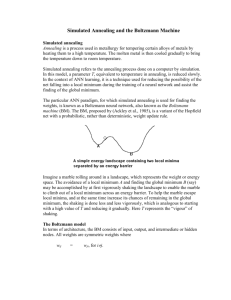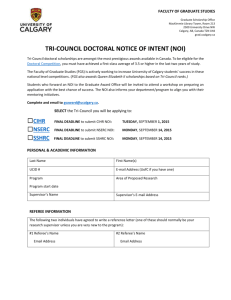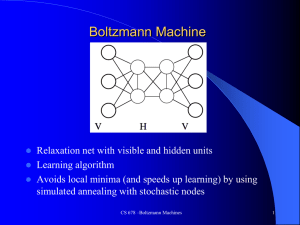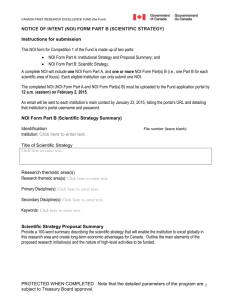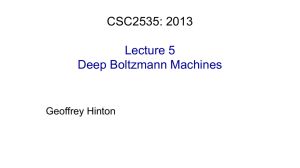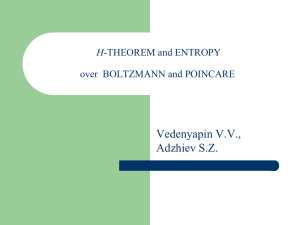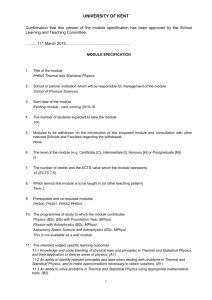Chapter 5: Boltzmann Machine
advertisement
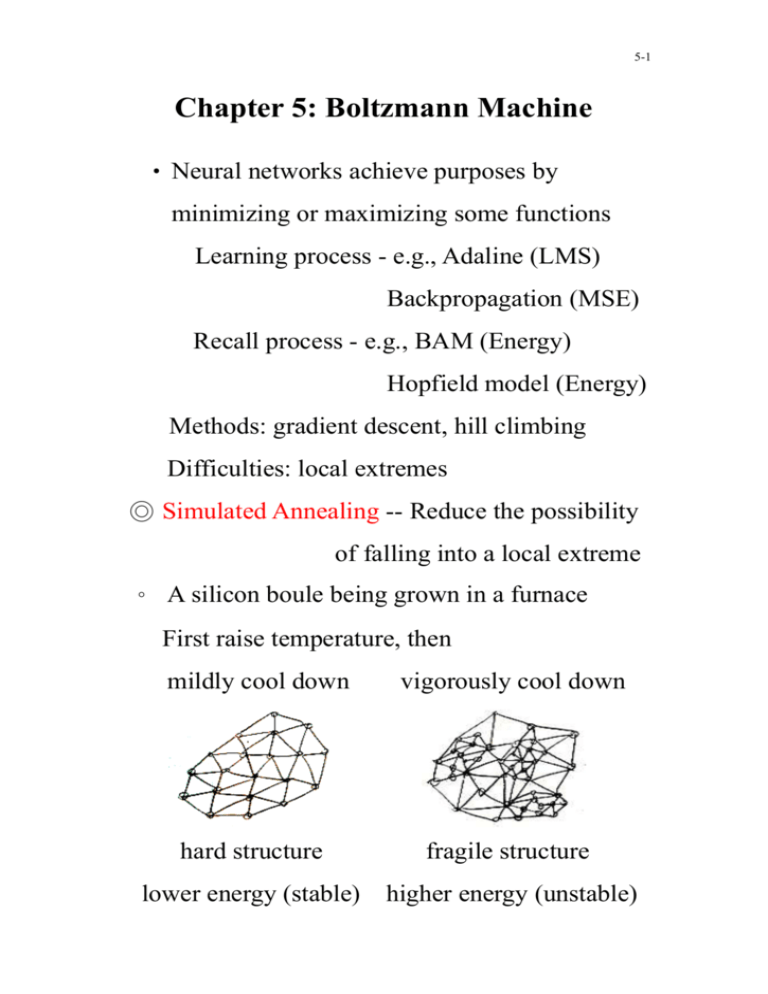
5-1
Chapter 5: Boltzmann Machine
‧ Neural networks achieve purposes by
minimizing or maximizing some functions
Learning process - e.g., Adaline (LMS)
Backpropagation (MSE)
Recall process - e.g., BAM (Energy)
Hopfield model (Energy)
Methods: gradient descent, hill climbing
Difficulties: local extremes
◎ Simulated Annealing -- Reduce the possibility
of falling into a local extreme
。 A silicon boule being grown in a furnace
First raise temperature, then
mildly cool down
vigorously cool down
hard structure
fragile structure
lower energy (stable) higher energy (unstable)
5-2
○ A thermal system that is initially at
temperature T0 is changed to T
。 The system reaches an equilibrium state after a
sufficient time period
However, particles interchange their energies
one another
Histogram
Probability
distribution
distribution
In an average sense, the system energy at the
N
equilibrium state is ET Ei PE
i i
i 1
The system energy actually fluctuates around ET
5-3
。 A particle system at temperature T whose
energy follows the Boltzmann distribution
p ce
E
where 1/ kT
k: Boltzmann constant
T: Kelvins (absolute) temperature
◎ Entropy - the average coarseness of particles
The coarseness of a particle with energy E
1
H log log p
p
Entropy: H <H i > = pi H i pi log pi
i
i
5-4
5.1. Information Theory and Statistical Mechanics
5.1.1. Information Theory
e : event ,
p(e) :probability of occurrence
if e occurs ,we receive
1
bits of information
I (e) log 2
p (e)
。 Bit: the amount of information receives when
any of two equally probable alternatives
is observed, i.e., p(e)
1
2
1
log 2 2 1 bit
1/ 2
Let p(e) 1 I (e)=log 21 0 bit
I (e) log 2
This means that if we know for sure that an
event will occur, its occurrence provides no
information at all
。 An information source
-- A sequence output of symbols from the
set S s1 , s2 ,..., sq with occurring
probabilities
p(s ), p(s ),..., p(s )
1
2
q
5-5
。 Zero-memory source: the probability of sending
each symbol is independent of symbols
previously sent.
The amount of information received from
1
each symbol is I ( si ) log 2
p( si )
Entropy: the average amount of information
received per symbol
q
q
i 1
i 1
H ( s) I p( si )I ( si ) p( si )log 2 p( si )
。 Entropy corresponding to a measure of disorder
in a system
The most disorderly system is the one whose
symbols occur with equal probability
Proof:
Two sources contain q symbols with
symbol probabilities
p1i , i 1,..., q s1 , p2 j , j 1,..., q s2
q
p
i 1
ri
1 ,
q
p
2j
j=1
1
5-6
The difference in entropy between the two
sources
q
H1 H 2 [ p1i log 2 p1i p2i log 2 p2i ]
i 1
q
[ p1i l o g2 p i 1 p i
i 1
1
l opg2 i 2
p1i log 2 p i2 p i log
p2 i ]
2
2
q
p1i
[ p1i l o g2
p( 1i p 2i ) l o2 pg i2
p
i 1
2i
q
p1i log 2
i 1
q
( p
i 1
1i
p1i
p2i
p2i )log 2 p2i ------ (5.6)
If s 2 is a source with equiprobable
symbols, then
1
p2i , log 2 p2i log 2 q c (constant)
q
q
( p
i 1
1i
q
q
i 1
i 1
p2i )c ( p1i p2i )c
(1 1)c 0
The second term in (5.6) is zero
]
5-7
q
q
p1i
p2i
H1 H 2 p1i log 2
p1i log 2
p
p1i
i 1
i 1
2i
q
p1i
where p1i log 2
: information gain
p
i 1
2i
(relative entropy or Kullback-Leibler
divergence) between the probability
functions p1i and p2i )
log x x 1
q
q
p2i
p
p1i log 2
p1i ( 2i 1)
p1i i 1
p1i
i 1
q
q
i 1
i 1
p2i p1i 1 1 0
H1 - H 2 0
5-8
5.1.2. Statistical Mechanics
-- Deal with a system containing a large number
of elements
e.g., thermodynamics, quantum mechanics
Overall properties are determined by the
average behavior of the elements
○ Thermodynamic System
The probability pr that a particle is at a
certain energy Er
pr ce Er (Boltzmann or Canonical
distribution)
p
r
r
1, c ( e
Er
r
e Er
) , pr
e Ek
-1
k
The statistical average of energy
e Er
E pr Er
Er
Ek
e
r
r
k
Er
e
Er
r
z
Entropy: s kB pr ln pr
r
5-9
○ Two systems with the respective entropies
s1 kB p1r ln p1r , s2 kB p2 r ln p2 r
r
r
Suppose they have the same average energy,
i.e., E1 p1r Er p2 r Er E2
r
r
Suppose p2r follows Boltzmann distribution
i.e., p2 r ce Er
The entropy difference between two systems
s1 s2 kB p1r ln p1r kB p2 r ln p2 r
r
r
p
p1r ln 1r ( p1r p2 r ) ln p2 r k B
p2 r
r
r
ln p2 r ln(ce Er ) ln c ln(e Er ) c Er
( p
1r
r
p2 r ) ln p2 r ( p1r p2 r )(c Er )
r
c p1r p1r Er c p2 r p2 r Er
r
r
r
c E1 c E2
( E1 E2 ) 0
s1 s2 ( p1r ln
r
p2 r
)k B
p1r
r
5-10
p1r ln
r
p2 r
0 ( ln x x 1)
p1r
s1 s2 0
* A system following the Boltzmann
distribution has the largest entropy
5.1.3. Annealing
-- A system at a high temperature has a higher
energy state than at a lower temperature
Rapid cooling can result in a local energy
minimum
。 An annealing process lowers temperature
slowly and finds the global energy minima
with a high probability.
At each temperature, sufficient time should be
given in order to allow the system to reach an
equilibrium following the Boltzmann
distribution p ( Er ) e
Er
k BT
5-11
。 Hopfield network: looks for the nearest local
minimum by deterministically updating
outputs of nodes
Boltzmann Machine: lets the output value of
each node be determined stochastically
according to the Boltzmann distribution
5.2. Boltzmann Machine
○ Features:
1. The output of PEs is a stochastic function
of the inputs.
2. The production algorithm combines an
Energy minimization with an entropy
maximization
5-12
○ Two different types of architecture:
1. Boltzmann completion network
2. Boltzmann I/O network
5-13
◎ Boltzmann Completion Network
Objective: to learn a set of input patterns and
then to supply complete patterns if partial
or noisy patterns are presented.
Input patterns: binary vectors
1 n
。 The system energy E
2 i 1
n
j 1,i j
(no self-loop)
wij xi x j
n : # units (both hidden and visible)
xk : the output of the k th unit
。 Suppose the system has learned a set of binary
vectors encoded in a set of weights.
Given an incomplete pattern
x (0, u,1,0, u,1,0), where u: unknown
of a stored pattern x (0,1,1,0,0,1,0)
To recall x
1. Set the outputs of known visible units to
the values specified by x
2. Set outputs of unknown visible units and
hidden units to random values from 1,0
5-14
3. Set the initial temperature to a large T T0
4. Calculate the net input net k of randomly
selected unit xk ( hidden or visible node)
1
(sigmoid)
net k / T
1 e
Change xk if pk z
5. Calculate pk
z : a uniform random number from 0,1
6. Repeat 4 and 5 until all units have had
some probability of being selected for
update (one processing cycle)
7. Repeat 6 several cycles, until equilibrium
(having the maximal entropy) has been
reach at the given T
8. Lower T and repeat steps 4 though 7
Once T has been small enough, the network
stabilizes (having the minimal energy) and
the result is the outputs of the visible units
◎ Boltzmann I/O Network
The input vector is clamped at the visible
layer and is never updated
5-15
All hidden and output units are updated
according to simulated annealing
5.2.2. Learning -- Using simulated annealing
and gradient decent techniques
-- The learning algorithm attempts to cause the
network to form a probability model of the
population based on the given examples
-- There are often many different models that are
consistent with the examples. How to choose
among the various models?
-- Insist the model to lead to the most homogeneous
distribution of input patterns consistent with
the examples supplied.
。 Example:
3D vectors (_, _, _) in a population P,
whose components {1,0}
Suppose vectors of type (1, _, _) have 40%
in P. There are many choices, e.g.,
5-16
P(1, 0,1) 4%, P(1, 0, 0) 10%
40%
P(1,1, 0) 8%, P(1,1,1) 18%
The most homogeneous distribution is
P(1, 0,1) 10%, P(1, 0, 0) 10%
40%
P(1,1, 0) 10%, P(1,1,1) 10%
i.e., equal probabilities to each case.
。 In an information source, if symbols possessed
1
equal probability of occurrence, i.e., pi ,
q
the source has the maximum entropy.
。 In a physical system in equilibrium at some
temperature T, the system possessing the
Boltzmann distribution of state energy has
the maximum entropy.
。 Boltzmann distribution: pr ce E ce
r
Er
k BT
As T , pr c , i.e., equiprobable states
(most homogeneous)
5-17
。 In terms of maximum entropy,
a physical system with Boltzmann states
an information source with equiprobable
symbols
。 The information gain of S 2 w.r.t. S1 is
defined as G P1r log
r
P1r
P2 r
※ A learning algorithm that discovered
weights w that minimized G would lead
ij
the network from state S2 to state S1
。 The closest to the Boltzmann distribution,
the maximum entropy and minimum energy,
the most homogeneous distribution of input
patterns
。 Training the Boltzmann machine
1. Raise the temperature of the NN to some
high value.
2. Anneal the system until equilibrium is
reached at some low temperature value.
5-18
3. Adjust the weights of the network so that G
is reduced.
4. Repeat 1~3 until observed
Boltzmann
distributions.
This procedure combines gradient descent (3)
in G and simulated annealing (2)
。 Given a set of vectors {Va } for being learned,
Defined {Η b } as the set of all possible
vectors that may appear on the hidden units
Clamp the outputs of visible units to each Va
。 Let P (Va ) : the probability that visible units
are clamped to Va
P (Va Hb ) : the probability that Va is
clamped to the visible units and
H b appears on the hidden layer
P (Va )
P
(Va H b )
b
Let P (Va ) : the probability that Va appears
on the visible layer without
clamping visible units
5-19
P (Va Hb ) : the probability that Va appears
on the visible layer and H b
appears on the hidden layer
without clamping visible units
P (Va ) P (Va H b )
b
An unclamped (free-running) system in
equilibrium at some temperature, the
probabilities are the Boltzmann probabilities
e E
P (Va H b )
Z
ab
T
Eab wij xi ab x j ab
i j
, where Z e E
mn
T
m ,n
ab
visible (Va )
, x : hidden (H ) unit
b
P (Va ) P (Va H b )
b
e
Eab T
b
Z
P
(V )
Information gain: G P (Va )ln a
a
P (Va )
P (Va ) P (Va )
G
wij
wij
a P (Va )
( P (Va ) independent of wij
clamping)
5-20
e
P (Va )
wij
wij
b
Z
Z
wij
e
1
T
Eab T
b
Eab T
b
e Eab T
Z
Eab wij xi x j
Z eE
mn
e
b
ab
i j
Eab T
Z2
Eab
wij
ab
b
Z
wij
e Eab T Z
Z 2 wij
Eab
xi ab x j ab
wij
T
m ,n
Z
Emn
( e Emn T )
e
wij wij m ,n
m , n wij
1 Emn E T
e mn
T wij
m,n
1
xi mn x j mn e Emn T
T m ,n
T
5-21
P (Va )
1 e E
wij
T b Z
ab
T
Eab
e E T Z
wij
Z 2 wij
b
ab
1 e E T ab ab
xi x j
T b Z
e E T 1
mn
mn E T
x
x
b Z 2 T
i
j e
m ,n
1
P (Va H b ) xi ab x j ab
T b
b e E T 1 e E T mn mn
xi x j
Z
T m ,n Z
1
P (Va H b ) xi ab x j ab
T b
P (Va )
mn
mn
P
(
V
H
)
x
x
m
n
i
j
T m ,n
ab
ab
mn
ab
mn
P (Va )
G
1
P (Va H b ) xi ab x j ab
wij
T a ,b P (Va )
+
P
a (Va )
+
P (Vm H n ) xi mn x j mn
T
m,n
P (Va Hb ) P ( Hb Va ) P (Va )
Likewise, P (Va H b ) P ( H b Va ) P (Va )
5-22
P ( Hb Va ) P ( Hb Va )
i.e., if Va is on the visible layer, then the
probability that H b will occur on the
hidden layer should not depend on
whether Va got there by being clamped
to that layer or by free-running to that
layer.
P (Va H b ) P (Va )
P (Va H b ) P (Va )
P
(V )
P (Va Hb ) a P (Va Hb )
P (Va )
G 1
( P ij P ij ) , where
wij T
P ij P (Va H b ) xi ab x j ab
co-occurence
a ,b
ab ab probabilities
P ij P (Va H b ) xi x j
a ,b
Weight update:
wij c
G c
( Pij Pij ) ( Pij Pij )
wij T
5-23
Pij , Pij : compute the frequency that xi ab
ab
and x j are both active averaged
over all possible combinations of
Va and H b
。Expand the algorithm of training a Boltzmann
machine by incorporating simulated annealing
process
1. Clamp one training vector to the visible
units
2. Anneal the network until equilibrium at
the minimum temperature
3. Continue for several processing cycles
(steps 1,2). After each cycle, determine
the pairs of connected units which are on
simultaneously (i.e. co-occurrence).
4. Average the co-occurrence results
5. Repeat 1~4 for all training vectors
Average the co-occurrence results to
get an estimate of Pij .
5-24
6. Unclamped the visible units
Run through 2~5 for calculating Pij
7. Change weights according
wij ( Pij Pij )
8. Repeat 1~7 until Pij Pij is sufficiently
small.
※ Arbitrarily assign initial weights
5.2.3. Practical Considerations
。 The learning process is very slow.
Geman & Geman show that the temperature
must be reduced according to
T (tn )
T0
1 ln tn ,
where T0 : Starting temperature
tn : the nth processing cycle
◎ Cauchy machine
a. Based on Cauchy distribution (
1
)
2
(1 x )
rather than the Boltzmann distribution
5-25
b. Annealing temperature follows
T (tn )
T0
1 tn
5.3. Symptom-Diagonosis Application –
Diagnose why a car will not start
。 Symptoms:
1. Does nothing, 2. Solenoid, 3. Grinds,
4. Cranks, 5. No spank, 6. Cable hot,
7. No gas
。 Possible causes:
1. Battery, 2. Solenoid,
3. Stater,
4. Wires, 5. Distributor,
6. Fuel Pump
。 Relationships
5-26
。 Solution:
1. Boltzmann
I
Network
2. Determine hidden units
Arbitrarily select 14 PE
Add more PE if training can not converge
Fewer PE in order to improve
performance
3. Training data sets
6 training vector pairs
5-27
